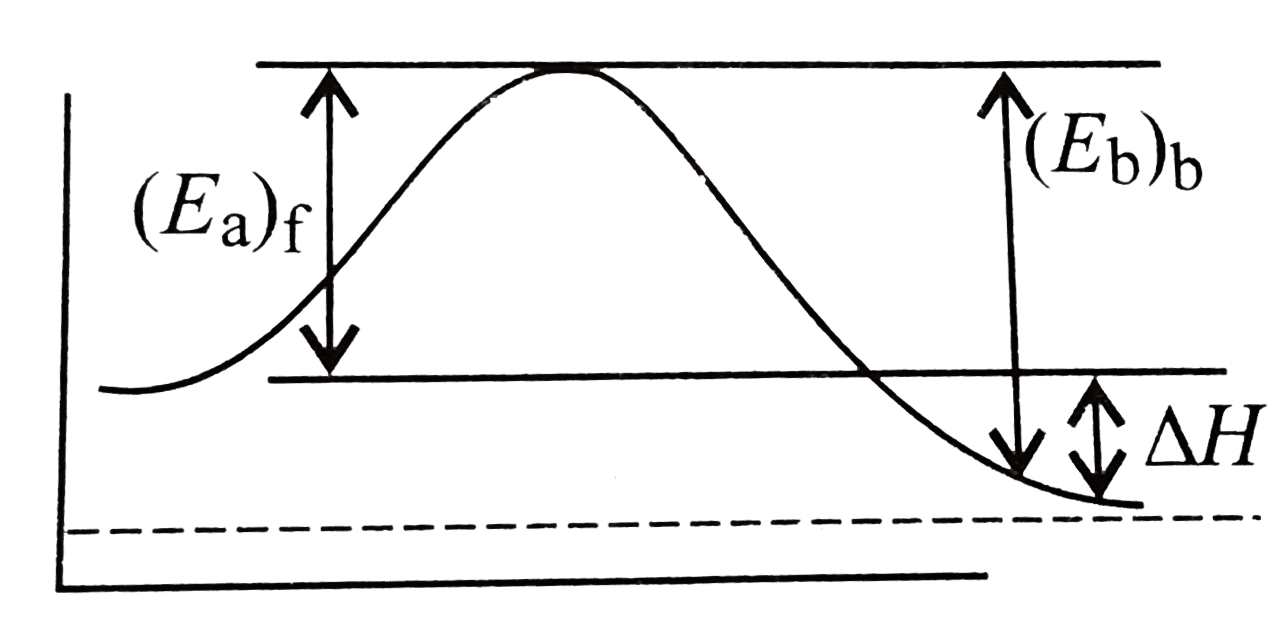An exothermic reaction A→B has an activation energy of 17 kJ per mole of A . The heat of reaction is 40 kJ . The activation energy for the reverse reaction B→A is Solution in Kannada
23 kJ
97 kJ
57 kJ
17 kJ
The correct Answer is:C
(C ) For exothermic reaction
Ea (backward ) =Ea (forward) + Heat of reaction ( magnitude only ) =17+40=57 kJ
Topper's Solved these Questions
- BOOK - MODERN PUBLICATIONCHAPTER - CHEMICAL KINETICS EXERCISE - Multiple Choice Questions (Level-II)50videos
CHEMICAL KINETICS
- BOOK - MODERN PUBLICATIONCHAPTER - CHEMICAL KINETICS EXERCISE - Multiple Choice Questions (Level-III)9videos
CHEMICAL KINETICS
- BOOK - MODERN PUBLICATIONCHAPTER - CHEMICAL KINETICS EXERCISE - Multiple Choice Questions ( Measuring Order of a Reaction : Integrated rate equation half life period )27videos
CHEMICAL KINETICS
- BOOK - MODERN PUBLICATIONCHAPTER - CHEMICAL BONDING AND MOLECULAR STRUCTURE EXERCISE - Recent Examination Questions17videos
CHEMICAL BONDING AND MOLECULAR STRUCTURE
- BOOK - MODERN PUBLICATIONCHAPTER - CHEMISTRY IN EVERY DAY LIFE EXERCISE - Recent Examination Questions4videos
CHEMISTRY IN EVERY DAY LIFE
Similar Questions
A first order reaction is carried out starting with 10 mol L−1 of the reactant . It is 40% complete in 50 min . If the same reaction is carried out with an initial concentration of 5 mol L−1 the percentage of reaction that is completed in 50 min is
02:34View SolutionThe half life period of a first order chemical reaction is 6.93 minutes . The time required for the completion of 99% of the chemical reaction will be ( log 2 = 0.301 ) :
03:14View SolutionFor a zero order reaction :
A→B
a graph of rate vs . Time has slope equal to :02:58View SolutionAmong the following, the compound that contains ionic, covalent and coordinate linkage is :
View SolutionOils are liquids at room temperature since they contain higher percentage of
View SolutionIn an exothermic reaction X→Y, the activation energy is 100kJmol−1 of X. The enthalphy of the reaction is −140kJmol−1. The activation energy of the reverse reaction Y→X is
 View Solution
View SolutionAn exothermic reaction ArarrB has an activation energy of 17 kJ per mole of A . The heat of the reaction is 40 kJ . Calculate the activation energy for the reverse reaction B rarr A .
02:42View SolutionIn an exothermic reaction A rarr B , the activation energy of the forward reaction is 200 kJ mol^(-1) . The enthalpy of the reaction is 280 kJ mol^(-1) . The activation energy of the reverse reaction B rarr A is
03:14View SolutionAn endothermic reaction A → B has an activation energy as × kJ mo1−1 of A. If energy change of the reaction is y kJ, the activation energy of the reverse reaction is :
03:14View SolutionAn exothermic reaction A → B has an activation energy of X kJ mol−1 of A. If the energy change in the reaction is Y kJ, then the activation energy of the backward reaction will be
01:08View SolutionIf a reaction A+B→C is exothermic to the extent of 30 kJ/mol and the forward reaction has an activation energy of 70 kJ/mol, the activation energy for the reverse reaction is
01:32View SolutionThe reaction A+B rarr AB has an enthalpy of reaction of -85.0 KJ- "mol"^(-1) . If the activation ehthalpy for the forward reaction is 120.0 KJ "mol"^(-1) , What is the activation energy for the reverse reaction AB rarr A+B?
02:29View SolutionAn exothermic reaction A→B has an activation energy of 17kJ per mole of A. The heat of the reaction is 40kJ. Calculate the activation energy for the reverse reaction B→A.
03:06View SolutionAn exothermic reaction A→B has an activation energy of 17kJ per mole of A. The heat of the reaction is 40kJ. Calculate the activation energy for the reverse reaction B→A.
02:00View SolutionIf a reaction A+B→C is exothermic to the extent of 30 KJ/mol and the forward reaction has an activation energy of 70 KJ/mol, the activation energy for the reverse reaction is
02:00View Solution
